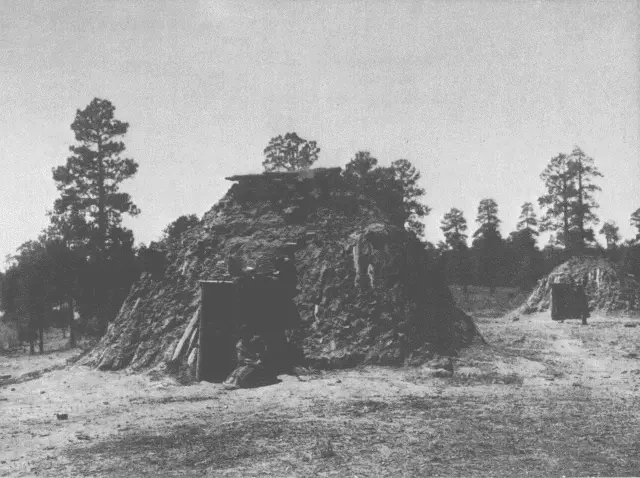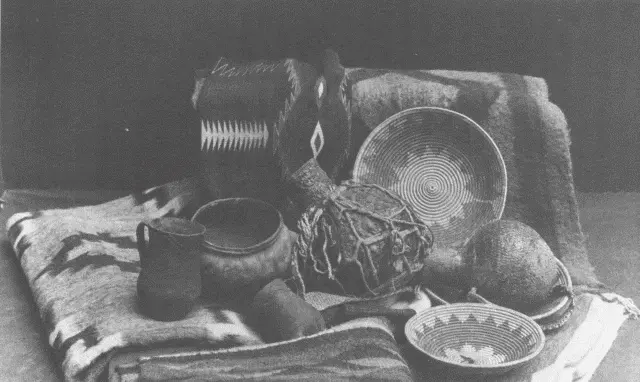While the statement is made that the Navaho were never a warlike people, it must not be presumed that they never caused our Government trouble. Those familiar with the Navaho admire their energy, industry, independence, and cheerful disposition, and their ability to attack the problems of life in a way that no other wandering tribe has exercised. On the other hand, cunning and trickery are among their characteristics, and they are expert horse-thieves. With the Indian, as well as with civilized man, honesty may be interpreted in various ways. If one should leave his camp equipage unprotected in a tent, it would be entirely safe from all except the renegade, already recognized by his people as a thief. But if one should turn his back and later find that his horse had been run off by a Navaho in the hope of being rewarded for returning it, the tribesmen of the raider would regard him as one whose cunning should be emulated.

Navaho Hogan
For a long period prior to the acquisition from Mexico of the territory now forming the northern portion of Arizona and New Mexico, which, since first known, has been occupied in part by the Navaho, the tribe had been in the habit of making raids on the New Mexican Indian pueblos and the white settlements along the Rio Grande, chiefly for the capture of livestock, although both Indians and Mexicans also were taken and enslaved. The Mexicans lost no opportunity to retaliate, with the result that scattered throughout their villages in the valley of the Rio Grande there were more captives of Navaho blood than there were Mexican prisoners among the Navaho tribe; but in the matter of sheep, cattle, and horses, the Navaho were far ahead in the game of thievery, and even boasted that they could easily have exterminated the Mexicans had they not needed them as herders of their stolen flocks. In consequence, bitter enmity early arose between the Mexicans and the Navaho, which reached its height about the time Col. Stephen W. Kearny took possession of the territory in behalf of the United States in 1846.
In the year named a military expedition was sent into the Navaho country for the purpose of making a treaty of peace and friendship with this marauding tribe; but this treaty, like several others that followed, was soon broken, and the raids continued as before. In 1858 the troubles arising from the plunderings became especially severe and led to several other expeditions, but with little result. The problem became a serious one in 1861, when the Civil War necessitated the withdrawal of troops from the frontier, leaving the way open to the devastation of the country by the Navaho and Mescaleros, until General Carleton, who assumed command of the military forces in New Mexico in 1862, formulated a policy to thoroughly subdue the Navaho and to transfer them to the Bosque Redondo, on the Rio Pecos in New Mexico, where Fort Sumner had been established, and there hold them as prisoners of war until some other plan could be devised. His plan was successfully carried out. By the spring of 1863 four hundred Mescaleros were under guard on the new reservation, and by the close of that year about two hundred Navaho prisoners had either been transferred thither or were on the way. Early in 1864 Col. Kit Carson led his volunteers to the Cañon de Chelly, the Navaho stronghold, where in a fight he succeeded in killing twenty-three, capturing thirty-four, and compelling two hundred to surrender. The backbone of the hostility was now broken, and before the beginning of 1865 about seven thousand, later increased to 8491, were under military control within the new reservation. But the Bosque Redondo proved unhealthful and disappointing as a reservation, while its maintenance was costly to the Government. A treaty was therefore made with the Navaho in 1868, one of the provisions of which was the purchase of fifteen thousand sheep to replenish their exterminated flocks. In July 7304 Navaho, the remainder having died or escaped, arrived at Fort Wingate on the way to their old home, where they have since lived in peace and prosperity.
Mythology - Creation Myth
Table of Contents
In the world below 5there was no sun and no moon, and therefore no light, yet vegetation in innumerable forms and the animal people thrived. Among the latter were Gray Wolf people, Naklétso; Mountain Lion, Nashtuítso; Badger, Naaschí̆d; Locust, Wónĕschĭdĭ; Pine Squirrel, Klozĕslskái and Klozĕslzhí̆nĭ; Blue Fox, Mai-Dotlí̆shĭ; Yellow Fox, Mai-Iltsói; Owl, Náscha; Crow, Gấgĕ; Buzzard, Jésho; four different varieties of the Hawk people, and many others.

Navaho Still Life
Their world was small. At its eastern rim stood a large white mountain, and at the south a blue one. These formed the home of Ástsĕ Hástĭn, First Man. A yellow mountain in the west and a black one in the north harbored Ástsĕ Ĕstsán, First Woman. 6Near the mountain in the east a large river had its source and flowed toward the south. Along its western bank the people lived in peace and plenty. There was game in abundance, much corn, and many edible fruits and nuts. All were happy. The younger women ground corn while the boys sang songs and played on flutes of the sunflower stalk. The men and the women had each eight chiefs, four living toward each cardinal point; the chiefs of the men lived in the east and south, those of the women in the west and north. The chiefs of the east took precedence over those of the south, as did those of the west over those of the north.
One day, led by their eight brave chiefs, all the men went off on a hunt. It occurred to the head-chief when they had been gone but a short time that the women should have been instructed to clean the camp thoroughly and bake a quantity of bread while all the men were away; so he despatched the youngest of the four chiefs of the south to the camp to make known his wishes, but instead of doing as bidden, the young chief visited with the head-chief's wife. The hunters were gone four days, at the end of which time they returned with much game, weary and very hungry. To their surprise they found the camp in a very unkempt condition and no bread baked in anticipation of their return. The messenger was called before the head-chief at once and questioned as to the directions he had given the women. He explained that he had told the chief of the women what they were expected to do, but she refused to listen to him, and he was powerless to do more. Then the head-chief went to his wife and demanded to know why she had refused to issue his orders to the women. She curtly replied that that was her business and not his; as it was, the women did more work than the men, for they tilled the fields, made the clothing, cared for the children, and did the cooking, while the men did practically nothing, so if they chose to spend a few days in idleness, it was nothing more than they had a right to do and no one's concern but their own. The chief became angry, and during a quarrel that ensued he was told that he and all his followers might leave if they would, for the women could get along better without them.
Remonstrance and reasoning availed nothing; the chief of the women grew more vehement as she argued, so the head-chief determined to put the women to the test. The following morning he issued orders that all the men in camp prepare to depart, for the women had declared they could live better independently of them and were to be given an opportunity to do so.
Читать дальше














